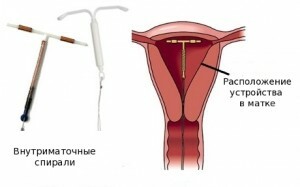Such a common thing as menstruation, can sometimes present unpleasant surprises. Most women are informed that this process is regulated by many factors: age, existing diseases, environmental and climate conditions, psychological state. But what if, it would seem, everything is still, and the next monthly with clots? First, do not panic. And most importantly, you should carefully study the possible causes of this phenomenon, and if necessary, contact a specialist. After all, sometimes the body signals in this way a serious disease.
What should be menstruation in norm
The meaning of the process in the possibility of conception and the birth of a child. Monthly discharges contain cells of the replaceable layer of the endometrium, mucus produced by the cervix, a vaginal secret. Their color at the very beginning of menstruation is a rich scarlet shade, the last couple of days - darker. The volume of excretions on different days is also different. It is at the first stage of an abundant period with clots should not be scary. It's nothing more than a blood curdled into the vagina. In critical days, women try not to show great physical activity, and at rest, excretions do not take longer. They have time to curl up and take the form of blood clots. If menstruation always goes by this scenario, you should not worry. Monthly without clots at all - a phenomenon almost unreal. If the discharge is literally poured, there is reason to suspect uterine bleeding.
When clots in menstrual flow are not the norm
Blood clots during menstruation in some cases are a symptom of gynecological disease or congenital pathology. The latter include:
- Features of the structure of the uterus. Sometimes its walls have partitions that can delay menstrual flow. Blood has time to fold significantly before it leaves the body;
- Anomaly of the development of the uterus called two-fold. It is characterized by a strong period with clots, lasting more than 7 days and giving the woman a noticeable pain.
Similar conditions are treated surgically if they interfere with conception.
Hormonal failure
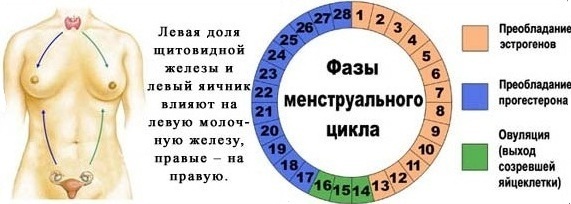
Blood clots with monthly, the causes of which lie in the area of hormones, are observed most often. After all, everything related to critical days is regulated by their balance in the body. Of great importance is the functioning of not only the ovaries that produce FSH, but also other organs. Hormonal disorders and menstruation with blood clots, can cause malfunction:
- Schitovidki;
- of the Adrenal;
- Pituitary;
- of the brain.
In any of the cases, a monthly dark brown color appears with clots. Not only the consistency of the discharge changes, the temperature rises, there is lumbar pain. Identify this very reason can study the blood on hormones.
Climax
Attenuation of the reproductive function after 50 years is inevitable. In all women, the menopause period is characterized by individual characteristics. Common are the changes in the hormonal background, which give out either scanty menstrual discharge, or with blood clots appear at monthly intervals, and they themselves become more abundant, although they go irregularly. Women of this age should be attentive, since the described symptom can also warn of a gynecological disease. In order not to start its possible development, you should visit the doctor at least less than in the young years.
Endometriosis
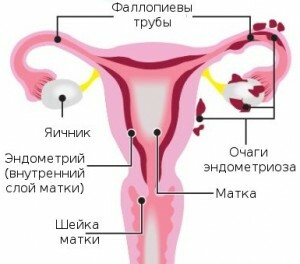
This is a disease of the organ, part of which is rejected during menstruation. If a woman has such a diagnosis, do not be surprised why the menstrual flow clots. The proliferation of endometrial tissue disrupts the balance of hormones, changes also occur at the cellular level. Allocations become more abundant, even if the woman does not feel pain yet. Developed endometriosis manifests as aching sensations before and after critical days. But before this stage it is better not to bring, since it is a direct path to infertility. Menstruations with clots will make it clear to a woman that she needs to go to a gynecologist. Get rid of endometriosis with hormones or a surgical scalpel.
Benign neoplasm of the uterus
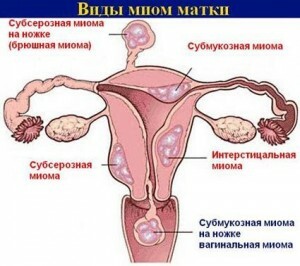
Myoma of the uterus is characterized by bleeding and beyond critical days. Nodes on the walls of the organ, single or merged, also provoke copious periods. Menstruation with clots is one of the first signs of the disease. The early stage of fibroids can be defeated with medicines, preserving the organ and the ability to give birth to a child. The newly developed tumor will have to be treated by surgical methods. Cautious should be women with hereditary predisposition, irregular sexual life, transferred gynecological operations.
Endometrial polyposis
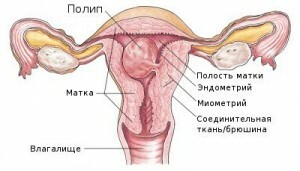
Growth on the surface of the endometrium of polyps provokes abundant periods with small clots. If a symptom is added to the daub of the critical days, pain in the abdomen, highlighting of a light color, most likely it is a polyposis. Previously, doctors were confident that the disease occurs at a sufficiently mature age after childbirth, numerous abortions. But now there is his appearance in young girls.
Conditions after abortion and childbirth
Artificial termination of pregnancy even on a short term is a rough intervention in the processes occurring in the body. If there was an abortion, a woman should not ask why the clots come out with the monthly ones. After a similar operation, the cycle can not recover immediately. To aggravate the situation is capable of damage to the endometrium, not to mention the hormonal shock that the body tolerates. Menstruation can become much thicker, more abundant, the allocation is uneven.
The postpartum period is also characterized by hormonal changes. And although there is nothing more natural than childbirth, the critical days after them do not come immediately, and the monthly ones with blood clots are normal. Endometrial cells accumulate in the uterus cavity longer than usual and then leave uneven masses. The other cause of such menstrual discharge after birth may be the remains of the placenta.

Intrauterine device
This is a fairly common method of contraception. Especially it is popular among women who already have children. The design is installed in the uterine cavity and, naturally, can not help influencing menstruation. Monthly with pieces of endometrial tissue are observed quite often. In addition, the discharge becomes more abundant, and the process itself lasts longer. Specialists are forced to fight this, since menstruation exhausts a woman, deprives her of more blood than is permissible. Usually prescribed blood products and iron preparations. If therapy does not bring the desired effect, it will be necessary to change the way of protection from pregnancy.
Taking medications that cause menstruation
Monthly with large blood clots, the causes of which lie in the uncontrolled use of Dufaston, Utrosian, Norkolut and other medicines, have become frequent in recent years. Wanting to cause lagging monthly, young girls themselves drink these pills. Not knowing the proper dosage, it's easy to make a mistake and subject the body to a real hormonal attack. The functional layer of the endometrium grows, the secretions accumulate and, after stopping the medication, are withdrawn from the genital tract more actively and with clots.

Varicose veins of small pelvis
The disease can occur at a very young age. Allocations with varicose veins of the small pelvis are not that with clots, but women note that "the months are like snot."In adolescents, they are quite abundant and often are the only sign by which you can recognize the disease. For the period of growing up to this type of menstrual secretions, pain sensations are added. Especially noticeable they become in the second phase of the cycle.
Dangerous menstruation of dark color with bunches
Monthly dark color with clots quite often indicate a pathological process.
But the repetition of the menses of a black or brown color of an uneven consistency can tell a specialist about what happened to a woman:
- Miscarriage. This can be very early. The pain that a woman experiences in this case can be compared with the sensations of ordinary menstruation. Characteristic for the spontaneous termination of pregnancy are large clots with monthly gray-yellow color, that is, their size exceeds 4 cm;
- Cancer of female organs. It is possible to suspect its early stage, if liquid transparent excretions were observed before menstruation, and then went black or brown with clots.
How to restore the normal consistency of the monthly

The first step to this should be to check with a specialist and identify the cause of menstruation with clots. As a rule, the doctor strives to exclude oncological diseases, and then conducts complex diagnostics. The most informative studies in this regard are laparoscopy and hysteroscopy.
Absence of pathological causes - the ability to normalize menstruation with ascorutin or calcium gluconate. They restore the cycle and reduce the amount of secretions.
All other culprits of the abnormal type of menstruation are treated in accordance with medical standards:
- With a lack of hormones, prescribe progestational medications;
- From fibroids get rid of with blood-resuscitative and monophasic preparations, embolization( obstruction of blood supply to the tumor), surgery;
- Closer to the menopause period, the body of the woman is filled with progesterone;
- Endometriosis is calmed by hormonal drugs or by surgery;
- Polyposis is removed with a scalpel, scraping is performed.
Almost all cases prescribed iron preparations.
Monthly with clots should not be treated home-grown. Most of them can lead to even greater problems if they are misused. With disturbing changes in the type of menstruation, the best way is to visit a specialist and examine. It is possible that in the consistency of monthly excretions with clots there is nothing serious.
When using any medication, you should consult a doctor, there are contraindications.

